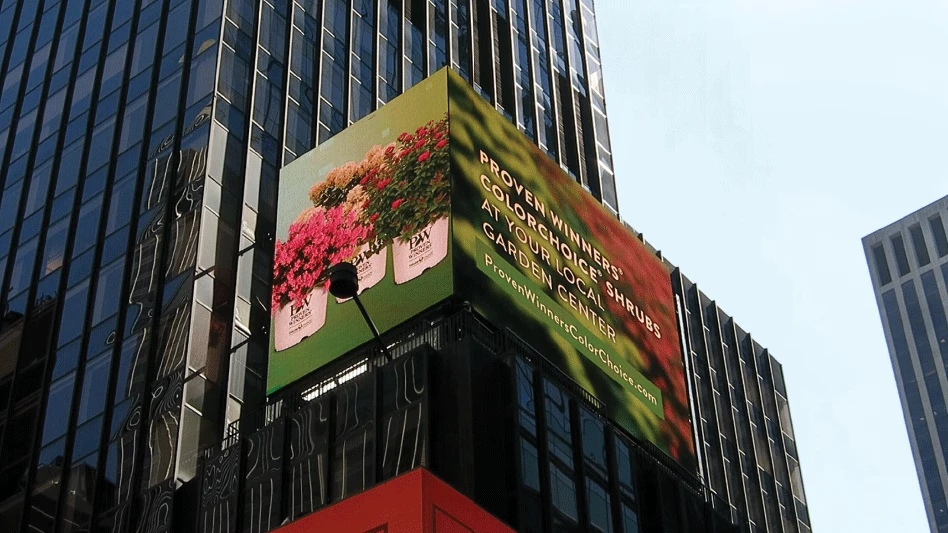
Photo: Proven Winners ColorChoice Shrubs
There is a saying in Chicago that if you don’t like the weather, wait 15 minutes. What that really means is grab your sunglasses, pack your umbrella, and put a sweater in the car.
Growing green brands in today’s business climate is a lot like that. Sometimes it’s sunny. Sometimes it’s cloudy with a chance of rain. If you are not nimble, you can’t be quick and that is the challenge of today’s plant marketer.
Companies that are not prepared for changes are those that slash their marketing budgets with belt-tightening and then wonder why they’re not making sales projections. If marketing is not working for you, chances are you’re not allowing it to do what it does best.
Marketing is a creative process that inspires, educates, and motivates people to buy plants. But you downplayed marketing or cut it from your budget. I understand.
We are a “right now” society and marketing requires patience. It is not widely known for delivering immediate results. But its effective results typically are long term because flexibility enables marketing to anticipate and adjust to marketplace trends.
Marketing is not selling. It is not advertising. It is not for the “numbers people” to crunch. Rather, marketing is an integral partner in the mix of business that supports the growth and evolution of the brand.
Through the years I have heard wholesale plant growers say they do not need marketing because they do not sell direct to consumers. If that is your mantra, you may want to brush up on what is happening with the competition and take a good look at the business climate around you. Because your business does, in fact, need marketing. All businesses do. And in this industry, we are all connected.

Convincing your customers to care
Knowing your wholesale trade customer is hugely important. So is knowing your trade customer’s audience. Their audience is your end consumer.
Whether business-to-business or business-to-consumer, educating your customer about what you do, and how and why you do it, matters to the success of every link in the chain of the ornamental plant industry. Arming customers with information about the unique benefits and characteristics of plants is the responsibility of all of us, no matter in whose yard that plant lands or who put it there.
Why should customers care? Because we all know plants matter. Our environment matters. Oh, I know. “People still won’t care.”
I hear that a lot from colleagues. I really do not believe it is true. But I understand the frustration packed into the statement, which also answers the “why should I have a marketing function” question.
It’s marketing’s job to address the implications packed into “people still won’t care.” Marketing does this by crafting opportunities for inspiration and education, with the goal of motivating consumers to buy and plant plants because plants have value.
Inspiration is the first leg of the three-legged stool of marketing. But without education – which is Leg No. 2 and the best asset in our industry’s marketing toolshed – inspiration is meaningless to Leg No. 3, which is motivation.
I am reading a brilliant book that is a masterclass on strategic marketing. “Creativity, Inc.” is written by Ed Catmull (with journalist Amy Wallace), who before he retired in 2019 served as president of Pixar Animation and Disney Animation. In it, Catmull addresses the challenges of growing a leadership brand during the infancy of video animation. His insights apply to any company that produces goods or services in a changing environment.
“We crave stability and certainty,” Catmull writes, “so we keep both feet rooted in what we know, believing that if we repeat ourselves or repeat what is known to work, we will be safe.”

Industry of innovation
Change is uncomfortable. It is human nature to want to continue to do what works. Repeat it over and over despite what marketing professionals tell us. Despite that change is once again in the wind and we had better be paying attention.
I like the way Stacey Hirvela puts it.
“It’s important to remember that to the average homeowner a spirea is a spirea, a rose is a rose,” she says. “Yes, they notice flower and foliage color. But as plant breeders develop more unique and useful features in ornamental plants, it’s important that those are called out to help the decision-making process.”
Hirvela is marketing manager, Proven Winners ColorChoice Shrubs in Grand Haven, Michigan. For this column, I chose to talk with Hirvela and to Nikki Melin, vice president of sales and marketing, Midwest Groundcovers LLC in St. Charles, Illinois. Both are brilliant marketing strategists with impressive horticulture backgrounds. They have fresh perspectives that provide unique insights into the business of marketing plants.
“Many people may remember the old days when petunias needed constant deadheading, roses needed spraying and hydrangeas were finicky and mysterious to care for,” Hirvela says. “These outdated beliefs persist even among younger people who are just getting into gardening and may have heard them from a parent or grandparent. Plants have changed so much in the last 20 to 30 years, and we need to educate people on the innovation that now characterizes our industry.”
Remember those old days? I do. We sat around conference tables wringing our hands over this new generation called Millennials and wondering if they would have the same fervent fondness for gardening their Boomer grandparents had. Our crystal balls could never have predicted a worldwide pandemic that would not only thrust Millennials outdoors, but their Generation X parents, Boomer grandparents and Generation Z siblings, as well.
As an industry we addressed stress relief. We showed how to grow food at home and modeled how to live outside our own back doors. Now it’s time to elevate the conversation as newbie plant enthusiasts graduate from Gardening 101 to 102, as companies realize that having employees work from home really does work for them, and another generation prepares to enter the marketplace. This newest generation’s reality is social media, artificial intelligence (AI) and online screentime saturated with advertising.

Progressive marketing
We have our work cut out for us. But as an industry we are heading in the right direction by marketing plants outside the proverbial beauty box. We just need to do it more. And the beauty of doing it more is that we cannot oversell plant value. Melin calls it “the value beyond the look.”
“Plants are incredibly valuable to the world around us, especially native plants,” she says. “They support our ecosystem, clean our water, clean our air, and support native fauna. What we are doing is really good for the world in many ways.”
Inspiring people about the beauty of plants is easy. Getting them to take action is the tricky part marketers know well.
“You don’t need to convince people plants are beautiful,” Hirvela says. “The image or video in the campaign tells that story on its own. You have to tell the story of what makes your product different or special and then move people through the marketing funnel to consideration and conversion.”
I am an avid follower of Charlie Hall, who, as chief economist for AmericanHort, advises industry on a variety of issues. He has been advocating for marketing the myriad benefits of plants for several years now. Back in 2020 he said, “We need to move beyond marketing beauty if we want to hold on to all the people who have become interested in gardening during COVID-19.”
“There is continued growing concern for the natural world,” Melin says. “Since COVID, there has been a stronger movement for people to spend more time outside and I do not see that going away. There is also more research and promotion of the health benefits of getting outside among plants and nature.”
Even in the four short years since COVID, how we define the benefits of plants has evolved and will continue to do so as environmental and cultural changes impact the way we live, work, and communicate. How we manage this approach to change is progressive marketing. Across the moving walkway of change, progressive marketing addresses the values and benefits of plants by speaking directly to the relevant issues that concern consumers.
“People are concerned about climate change and need confidence that the plants they buy will tolerate unpredictable temperatures and rainfall amounts,” Hirvela says. “There is huge interest in native species and varieties, but confusion and hesitation on how to start growing them. In getting people to take action, they are more likely to do so if the featured values and benefits speak to issues that they are concerned about but do not have the tools or knowledge to address.”
It is not safe to assume, she adds, that consumers who see our marketing messages understand they can purchase our products at a garden center, take them home and plant them outdoors in their landscape.
“Obviously we shouldn’t simplify things to the point of ridiculousness,” Hirvela says, “but our industry makes a lot of assumptions about what people already know about our products and what their values and priorities are. We cannot assume everyone has the same basic understanding we do. That runs a high risk of our marketing not landing in a meaningful way, of wasting money and squandering opportunity.”
Hirvela says call-to-action is a unique responsibility for our industry because the U.S. is not really a gardening culture.
“For our industry to grow, we need to grow the number of people who garden,” Hirvela says. “We need to plant the idea in their minds, remind them to go to the garden center when it’s time to plant and encourage them on their journey. This has become even more crucial since, for so many people, their first instinct is to go online when they decide to buy something.”

Marketplace of opportunity
From pay-to-play social media to juggling Google keywords, communications marketing platforms do not use “one size fits all messaging.” This is where our industry sometimes go sideways, especially on beauty messaging. For example, social media is more than Facebook for how-tos and Instagram for pretty pictures. Social media is a vast marketplace of opportunity with a wide variety of platforms that each have distinctive personality and priorities.
Successful social media management is not a 30-minutes-at-the-start-of-the-day task. To do it well, it takes hours to research, plan, develop and execute and for many it is a full-time job.
Effective social media strategy includes analysis of content and engagement metrics like competitive posting, time of day, and time spent on your page. Then, adjusting daily to what works and what doesn’t on each social media platform.
Social media “changes by the minute,” Melin says. “Most growers do not have the marketing resources to really understand what is effective and what to spend their time on. Most have someone doing it as a side project to their main job and many of these folks do not have a true marketing background. But the development of video content and engagement on social media is going to continue to become very important.”
Placement strategy on communications platforms requires understanding of the product and its values, benefits, and attributes. It also requires understanding of the distinct audiences following specific channels. Opportunities abound for customization and creativity. These are the tools in the wheelhouse of our industry’s educated marketing professionals.
“There is strategy in which channels we utilize,” Hirvela says, “how much we budget for each one and timing. The tactical portion comes in as we consider our messaging. What are our ads going to say on each channel? Which images are we going to use? What should our videos say and look like? We aim for an omnichannel marketing approach, which is multichannel marketing with all the channels connected. As such, people are likely to experience our marketing across all media, but different messages resonate better on different channels, and the format of the channel determines what is best to say and how to say it.”
Many more platforms for plant marketing does not mean the playing field is wide open for business. For example, advertising is less expensive than ever, but that means more advertisers competing for that space. And competition is fierce as we participate in the world of marketing, not just in the world of plant promotion.
“From ad blockers to the skip button on YouTube to the advance 30-seconds button on podcasts, it’s harder to be heard and seen,” Hirvela says. Noted marketing author “Seth Godin famously said, ‘Marketing is a contest for people’s attention,’ and that attention is getting harder and harder to get.”

Fighting for truth
Reputation management has always been part of the job of any marketing professional. AI presents a major new challenge unlike any we’ve seen before. To protect the reputation of our plant companies - and of industry overall - marketers must be vigilant about protecting integrity and fighting for truth.
“There are already so many AI-generated fake plants and scams out there that it will become even more crucial to establish trustworthiness and authority as real plant companies,” Hirvela says. “Similarly, when people have gardening questions, AI has yet to notice the many, many nuances that impact plant performance. The answers people are getting when they ask the Internet are less helpful, which gives us an opportunity. And that in and of itself is a new marketing challenge.”
Bottom line: marketing is worth the investment and most companies cannot afford to be without it. In addition to bringing on a marketing professional you will need a photographer who can shoot videos. Having drone capability on the nursery is a bonus. Yes, it is a dedicated job. Yes, it is budget and labor intensive. Yes, it is an investment in the growth of the brand.
“Whether it’s new rules governing data collection or new marketing and advertising outlets or AI, there is new stuff to learn about and implement every year and, with that, new creative formats, lengths, and sizes,” Hirvela says. “Keeping up on that so you continue to meet your audience where they are – with content that informs and engages – creates fresh challenges every season. But I believe some of the challenges will be alleviated by the simple fact that more of us are marketing.”
And that is incredibly good for industry. Because another change is inevitably in the wind – and it is best to be prepared.

Explore the July 2024 Issue
Check out more from this issue and find your next story to read.
Latest from Nursery Management
- Pennsylvania Horticultural Society shares top gardening trends from 2025 Philadelphia Flower Show
- California Spring Trials 2026 dates announced
- Les Evans promoted to DRAMMwater segment manager, Al Zylstra to retire
- Hoffmann Family of Companies to acquire N.G. Heimos Greenhouses
- GIE Media Horticulture Group wins five regional 2025 Azbee Awards of Excellence
- How to create a sustainable plant nursery
- Grant awarded to test western U.S. wood species for use as wood fiber potting substrate
- Pennsylvania Horticultural Society announces 2025 Gold Medal Plant winners





